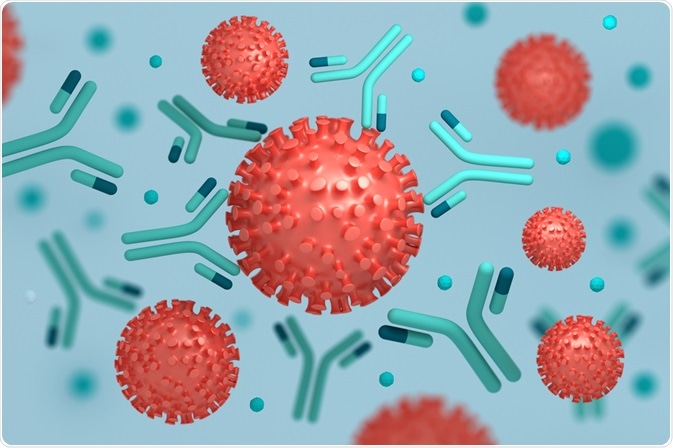The understanding of disease requires knowledge of specific biological structures present in disease-causing organisms. This knowledge informs the effective development of preventive treatments and vaccines. This article will explain what one of these structures, the epitope, is and how mapping it is important for medical science.
 Image Credit: DariaRen/Shutterstock.com
Image Credit: DariaRen/Shutterstock.com
The epitope
An epitope is the part of an antigen that the host’s immune system recognizes, eliciting the immune response to an invading pathogen. It specifically binds to the corresponding antigen receptor on the immune cell (such as a B cell) and binding only occurs if the structures are complementary.
Once epitope and receptor bind together in this puzzle-like combination, the production of antibodies is stimulated. These antibodies are specifically targeted to the epitopes that bind to the antigen receptors. In this manner, the epitope is also the region of the antigen that is recognized by the specific antibody which then removes the antigen from the host organism after binding to it. The region on the antibody which binds to the epitope is known as the paratope.
Many antigens have a number of distinct epitopes on their surfaces. Each of these epitopes can interact with different antigen receptors on immune cells. The blood serum of an immunized person usually contains a mixture of antibodies that can bind with different epitopes on the surface of an antigen. Antibodies that target with the same epitope can have different abilities to bond with it.
The epitope is also referred to as the antigenic determinant. It is usually a non-self protein. However, in the case of autoimmune diseases, sequences in the host can be recognized as epitopes by the immune system. Epitopes are generally around five or six amino acids in length.
Types of epitope
There are three types of epitope: conformational, linear, and discontinuous. This classification is based upon their structure and their interaction with the antibody’s paratope. Conformational epitopes are formed through the interaction of amino acid residues which are disconnected from each other. The number of conformational epitopes is unknown.
Linear epitopes are determined not just by their primary structure (sequence of amino acids) but also by other residues present. More distant amino acid residues of the antigen as well as those which flank the primary structure affect the linear epitope’s three-dimensional conformation.
Discontinuous epitopes consist of parts of the protein which are brought together by protein folding rather than being close to each other in the structure. This class of epitope can contain both conformational and linear parts. Data from various studies have provided evidence that most antigen-antibody binding occurs at discontinuous epitope sites. Protective antibodies (for example, those in vaccines) particularly rely on this.
T- and B- cells provide an immunologic response based on pathogen-specific memory. B-cell epitopes are the portion of the antigen that antibodies or immunoglobulin binds to. T-cell epitopes are found on the surface of an antigen-presenting cell and are bound to major histocompatibility complex molecules. Epitopes can be cross-reactive.
Antigenic Determinants (Epitopes) - Animation
Epitope mapping
Mapping epitopes is important for developing effective vaccines, diagnostics, and therapeutics. It helps identify the epitope site and elucidate the antibody’s binding mechanism. Information from epitope mapping can be incorporated into algorithms for in silico prediction of B-cell epitopes based on structural and/or sequence data.
Importance in therapeutic development
In therapeutic development, epitope mapping is used for the development of monoclonal antibodies. It reveals how they exert their functional effects. This includes mechanisms of action such as how it traps a protein in a non-functional state or how it blocks ligand binding.
Epitope mapping for this purpose can be challenging as many therapeutic monoclonal antibodies target conformational epitopes. This is because they are only present in the protein’s native state. However, researchers developing vaccines for several pathogens have used epitope mapping as an integral part of the process. This includes diseases such as Ebola and Zika.
Methods of mapping epitopes
There are several scientific methods that are used to map epitopes. These include X-ray co-crystallography, array-based oligo-peptide scanning, and hydrogen-deuterium exchange (HDX).
X-ray co-crystallography is the most widely used method because antibody-antigen interactions can be directly visualized using it. However, not all proteins can be crystallized, and this technique can be expensive, time-consuming, and technically complicated. Other methods listed above provide alternatives to this method which are less expensive and easier to carry out.
Other high-throughput methods such as yeast display, phage display, and limited proteolysis can be used for epitope mapping. Whilst these offer high-throughput monitoring, they lack resolution, especially for conformational epitopes.
In conclusion
The study and mapping of epitopes play an important role in the medical sciences. Accurate knowledge of antibody-antigen reactions, which epitope study helps to inform, is vital for developing effective vaccines and therapeutic drugs to combat emerging pathogens and help to respond better to future pandemics.
Further Reading
Last Updated: May 10, 2021